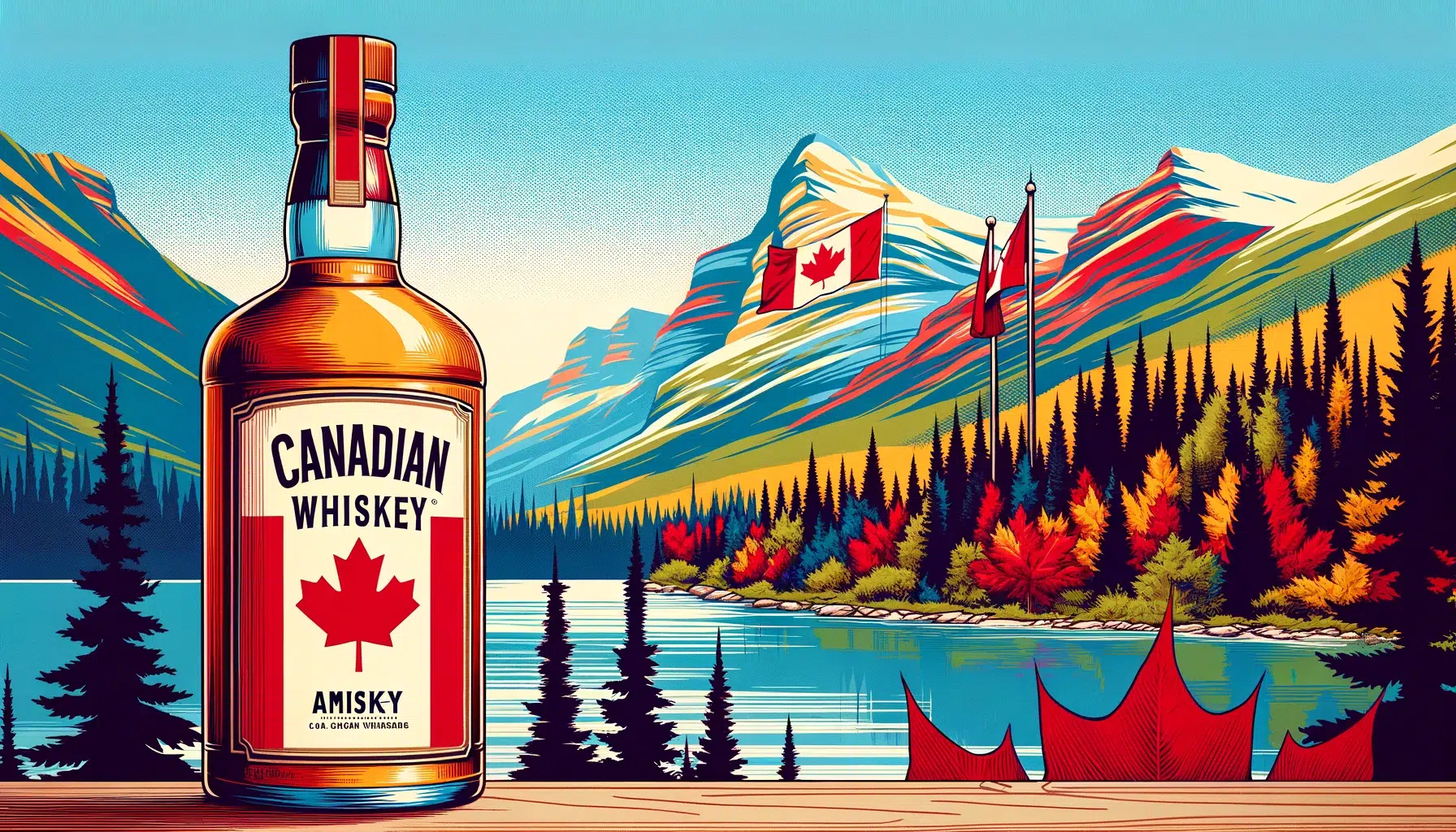Whiskies from all corners of the world offer a variety of flavors, yet Canadian whisky carves out its own special niche with a distinct charm.
Rooted in Canada’s rich tradition and expertise in distilling, Canadian whisky reflects the country’s diverse landscape and heritage. It’s celebrated for its smoothness and range of flavors, from rich and robust to delicate and subtle.
Prominent types include Rye, Corn, Single Malt, Blended, Flavored, and Wheat whisky, each notable for their distinct taste profiles and backgrounds. Canadian Rye whisky is particularly esteemed, known for its smooth and spicy notes.
This exploration will delve into the distinct attributes, production methods, and histories of Canadian whisky, along with suggestions for food pairings. Keep reading for a detailed journey through the world of Canadian whisky.
Types of Canadian Whisky
Canadian whisky presents a diverse array of styles, each marked by its unique ingredients, distillation methods, and flavor nuances. Rye Whisky stands out for its spicy and fruity characteristics, offering a bold taste even when rye isn’t the dominant grain. Corn Whisky leans towards a sweeter, more mellow flavor, appreciated for its smooth finish.
Single Malts are less common and are a relatively recent addition to the country’s whisky offerings, making them sought after by collectors and enthusiasts for their unique character and the distinctiveness. If you want to learn more about what makes a whisky a certifiable collectible, check out our article on whiskey collecting.
Blended Whisky embodies the artistry of blending, merging multiple whiskies into a complex and harmonious profile.
Flavored Whisky adds a uniquely Canadian touch with infusions like maple, broadening the whisky’s appeal with novel taste notes. Lastly, Wheat Whisky is prized for its soft and delicate flavor, offering a gentler introduction to the world of whisky.
Each category serves as a portal into the expansive and intricate universe of Canadian whisky, catering to a broad spectrum of palates and occasions with its rich variety.
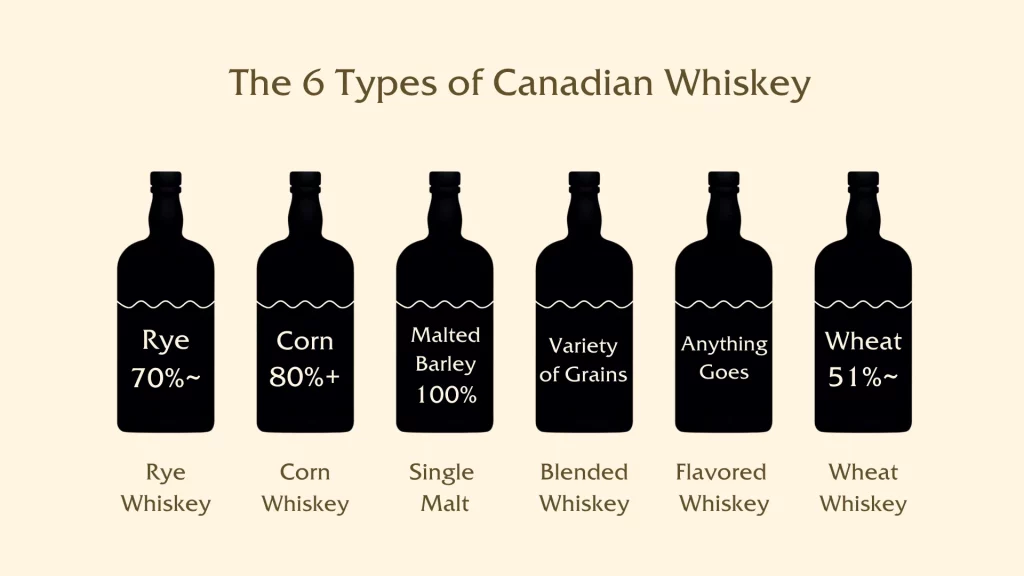
Rye Whisky
Rye Whisky is emblematic of Canadian whisky, distinguished by its bold, spicy flavor with possible notes of fruit and grain. Despite the name, not all rye whiskies from Canada are predominantly made from rye, but they all carry a zest that is uniquely characteristic of this type.
Corn Whisky
Corn Whisky is characterized by its sweeter, softer profile, attributable to a higher corn content in the mash. Its smoothness and mellow character make it a preferred choice for those seeking a gentle whisky experience.
Single Malt Whisky
Single Malt Whisky in Canada is a pure expression crafted from a single grain, typically barley, at one distillery. It is prized for its depth and complexity, offering a rich, nuanced flavor that resonates with whisky enthusiasts.
Blended Whisky
Blended Whisky is a harmonious mix of multiple whiskies, often combining grain and malt variants. This blending process results in a balanced and intricate flavor, demonstrating the artistry involved in creating a cohesive and smooth spirit.
Flavored Whisky
Flavored Whisky adds an innovative twist to traditional whisky flavors, with maple being a popular infusion. These whiskies strike a balance between classic whisky notes and sweet, aromatic additions, catering to a broader audience with a taste for novelty.
Wheat Whisky
Wheat Whisky stands out for its soft, delicate flavors and lighter body. Known for its subtlety and smooth finish, it provides an accessible option for those new to whisky or those who prefer a milder spirit.
Distinct Characteristics of Canadian Whisky
Canadian whisky is renowned for its light and smooth texture, setting it apart from other global whisky varieties. This hallmark smoothness makes it highly approachable and versatile, catering to a wide audience with varying taste preferences. Another pivotal attribute is its diverse flavor profiles, ranging from sweet and fruity to spicy and woody, showcasing the creativity and innovation of Canadian distillers.
Light and Smooth
Canadian whisky stands out for its light and smooth texture, making it highly approachable for both novices and connoisseurs. This smoothness is achieved through careful distillation and aging, ensuring a refined spirit that’s versatile in its appeal.
Diverse Flavor Profiles
The diverse flavor profiles of Canadian whisky showcase the artistry of its distillers. With a spectrum ranging from the sweetness of maple and vanilla to the spiciness of rye and the richness of oak, there’s a Canadian whisky to match every palate.
Flexible Grain Mash Bills
Flexibility in grain mash bill is a signature trait of Canadian whisky, permitting a variety of grains in its production. This not only encourages innovation and diversity but also enhances the distinctiveness and complexity of the whisky, allowing each distillery to produce unique and memorable flavors.
If you want to learn more about the production process and how the mash effects the outcome, check out our article on mashing.
The Rich Flavor Spectrum of Canadian Whisky
Canadian whisky unfolds a rich flavor spectrum that entices both aficionados and those new to whisky. Central to this spectrum are signature flavor notes like maple syrup and vanilla, imparting a unique sweetness and warmth to various blends.
The smoothness of Canadian whisky is a hallmark, enhancing its versatility whether enjoyed neat or as the cornerstone of a sophisticated cocktail. From bold and spicy to sweet and rich, the array of flavors mirrors the adaptability and innovation of Canadian distilleries. This diversity in taste profiles ensures that Canadian whisky offers a rewarding and nuanced experience for every preference.
If you want to appreciate your Canadian whisky to the fullest extent, check out our article on the whiskey tasting process.
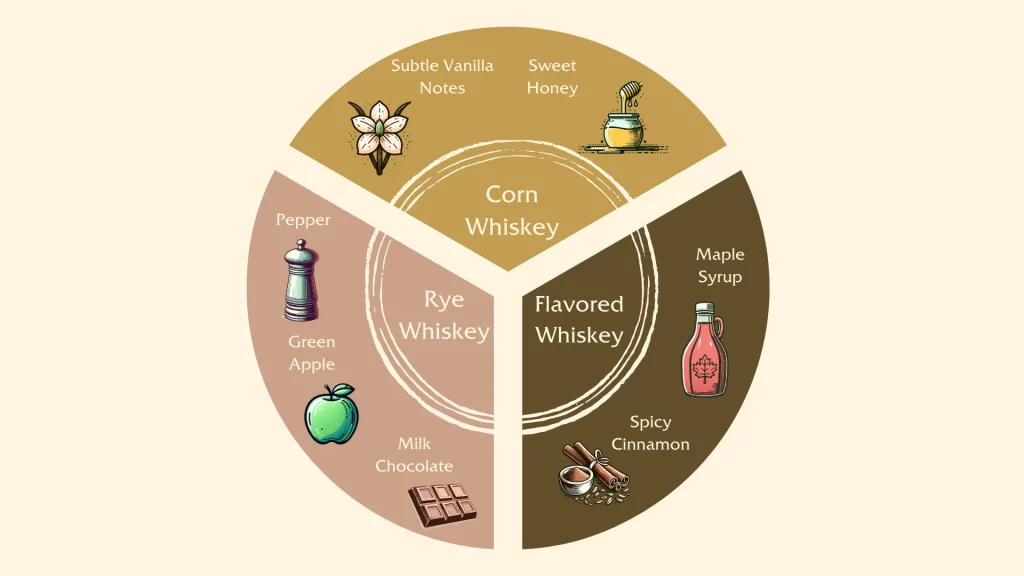
Signature Flavor Notes in Canadian Whisky
Canadian whisky captivates with its signature flavor notes, a symphony of tastes that distinguish it in the whisky world. From the deep, sweet embrace of maple syrup to the comforting warmth of vanilla undertones, these flavors are enhanced by the whisky’s hallmark smoothness, making each sip a layered and pleasurable journey.
Maple Syrup Notes
The maple syrup notes in Canadian whisky are a nod to the nation’s rich heritage, offering a sweet and rich flavor that adds depth and complexity. This distinctive sweetness makes the whisky uniquely appealing, inviting a deeper exploration of its nuanced profile.
Vanilla Undertones
Vanilla undertones lend a smooth and creamy texture to Canadian whisky, enriching its aroma and flavor palette. These subtle hints of vanilla weave through the whisky, enhancing its sophistication and allure, and making it irresistibly smooth.
Smoothness
The smoothness of Canadian whisky is unparalleled, serving as the foundation upon which its diverse flavor notes build. This smooth character not only makes the whisky approachable but also allows the intricate blend of flavors to be fully appreciated, ensuring a refined and enjoyable tasting experience.
Pairing Canadian Whisky with Food
Pairing Canadian whisky with food, from savory grilled meats to sweet desserts, leverages its versatile flavor profile, from light and smooth to bold and spicy, for a harmonious dining experience. This thoughtful approach to pairing opens up a world of culinary possibilities, transforming each meal into a one-two punch of flavor.
Complementing Flavors in Savory Dishes
Canadian whisky excels in pairing with savory dishes, where its rich and smoky undertones can elevate the meal. The boldness of the whisky complements the flavors of grilled meats, adding an extra layer of depth and complexity. For dishes that feature smoked elements or robust spices, Canadian whisky acts as a perfect counterbalance, smoothing out the intensity with its refined finish.
Complementing Flavors in Sweet Dishes
In the realm of sweet dishes, Canadian whisky shines by offering a delightful contrast with its notes of vanilla and maple syrup. Desserts such as pecan pie or crème brûlée are taken to new heights when paired with a whisky that echoes their inherent sweetness, while introducing a nuanced layer of flavor. The inherent smoothness of Canadian whisky ensures that the dessert’s sweetness is complemented, rather than overshadowed, resulting in a harmonious and indulgent pairing experience.
Which Canadian Whisky Should You Try First?
Choosing your the best Canadian whisky is an exciting journey into a world of rich diversity and flavor. If your palate favors gentle, smooth flavors, a lighter Canadian whisky with hints of vanilla and maple might be the perfect starting point. For those who are drawn to bold, spicy notes, a rye-based whisky can showcase the robust character and depth that Canadian rye is known for.
Meanwhile, lovers of sweet, rich profiles may find their match in a whisky that highlights the luscious sweetness of maple syrup undertones. Each selection offers a distinct pathway into the Canadian whisky experience, tailored to satisfy a broad spectrum of tastes and preferences.
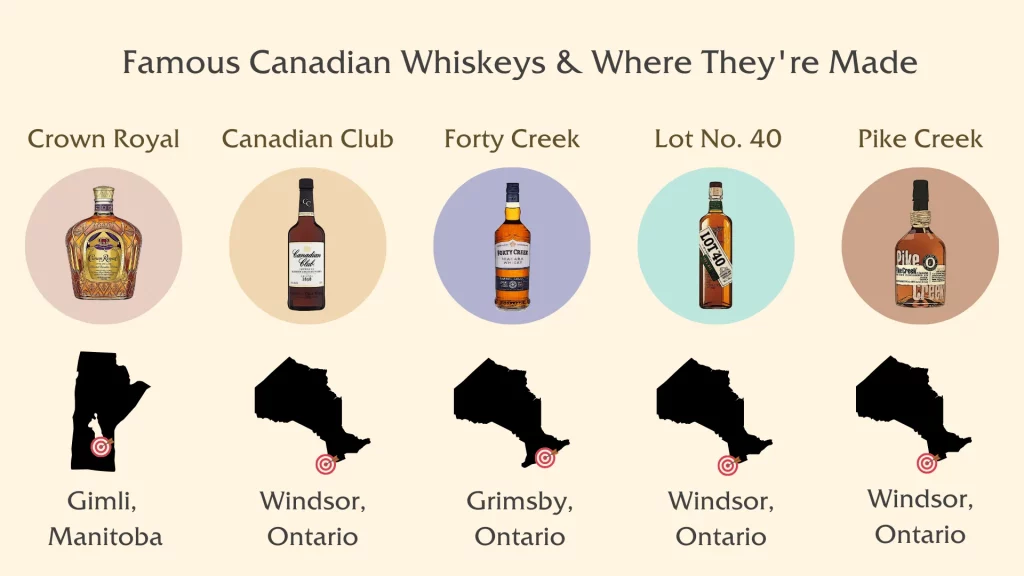
For Those Seeking Gentle, Smooth Flavors
For individuals drawn to gentle and smooth flavors, starting with a corn whisky is highly recommended. Its characteristic sweetness and silky texture offer an accessible and enjoyable entry into Canadian whisky, ideal for novices or those who favor subtler spirits.
For Enthusiasts of Bold, Spicy Notes
Those who crave bold and spicy flavors will be well-served by exploring rye whisky. Known for its vibrant spiciness and layered complexity, rye whisky delivers a robust and engaging taste experience, appealing to those who seek depth and intensity in their whisky.
For Lovers of Sweet, Rich Profiles
For aficionados of sweet and rich flavors, flavored whiskies incorporating notes of maple or vanilla offer a decadent tasting journey. These whiskies merge the traditional warmth and richness of whisky with creative sweet infusions, crafting a distinctive and indulgent flavor experience.
Regulation Requirements Of Canadian Whisky
Canadian whisky is governed by strict regulation requirements that safeguard its quality and authenticity. For a spirit to be labeled as Canadian whisky, it must be distilled and aged in Canada for at least three years in wooden barrels, with oak being the most common choice. These regulations ensure that the whisky exhibits the aroma, taste, and character traditionally associated with Canadian whisky.
Additionally, the final product must have an alcohol content adjusted to no less than 40% by volume through the addition of pure water. These stringent standards maintain the integrity of Canadian whisky, guaranteeing that each bottle delivers an authentic experience reflective of Canada’s rich whisky heritage.
Impact on Flavor and Quality
The aging process in wooden barrels, particularly oak, is a critical factor in developing the unique flavors and aromas of Canadian whisky. During this period, the whisky undergoes chemical transformations that enhance its complexity, smoothness, and overall taste profile. Here’s how these regulations impact the whisky:
- Wood Interaction: The interaction between the whisky and the wood infuses the spirit with distinctive flavors such as vanilla, caramel, and toffee. Oak barrels also contribute tannins, which add depth and structure to the whisky.
- Oxidation: The slow oxidation process that occurs in the barrel helps mellow the whisky, rounding out harsh edges and integrating flavors.
- Climate Influence: Canada’s diverse climate, with its cold winters and warm summers, affects the aging process by influencing the rate at which the whisky expands into and contracts from the wood, further enhancing flavor extraction.
History of Canadian Whisky
The history of Canadian whisky is a captivating journey that intertwines with the nation’s past. Originating with early distillation practices in the 18th century, it laid the groundwork for a flourishing whisky industry. By the 18th Century Beginnings, distilleries were emerging to cater to the increasing demand, marking the dawn of Canadian whisky’s prominence.
The Prohibition Impact presented significant challenges, yet it also underscored Canadian whisky’s resilience, especially during the Bootlegging Era, when it was clandestinely transported into the United States. Transitioning into the Modern Era, Canadian whisky has continued to evolve, embracing innovation while honoring its rich heritage. This evolution from its modest origins to worldwide acclaim highlights the enduring legacy and versatility of Canadian whisky.
Early Distillation
The roots of Canadian whisky can be traced back to the late 1700s when early settlers and farmers began distilling surplus grains. One of the pioneering figures was John Molson, who established his distillery in Montreal in 1799, laying the foundation for what would become one of Canada’s most iconic beer and whisky brands.
18th Century Beginnings
In 1801, the Gooderham and Worts Distillery was founded in Toronto, initially as a mill before evolving into one of the largest whisky producers in the British Empire. Their contribution to the whisky industry set high standards for quality and innovation, significantly influencing Canadian whisky’s development.
Prohibition Impact
During Prohibition in the United States (1920-1933), Canadian whisky found its way across the border, leading to a boom in production and smuggling operations. Notable figures like Sam Bronfman, the founder of Seagram’s, capitalized on this demand, establishing a legacy that would dominate the Canadian whisky industry for decades.
Bootlegging Era
The Bootlegging Era saw Canadian distillers, including Hiram Walker, founder of Canadian Club, navigating the challenges of Prohibition. Their ability to legally produce whisky for “medicinal purposes” and subsequent smuggling efforts helped sustain the industry and solidify Canadian whisky’s reputation abroad.
Modern Era
The modern era of Canadian whisky has been marked by a resurgence in craft distilling and a renewed interest in premium, small-batch whiskies. Distilleries like Forty Creek in Grimsby, Ontario, founded in the 1990s by John K. Hall, have played a significant role in this renaissance, introducing innovative blends and single malts that have garnered international acclaim.
This enriched history of Canadian whisky, highlighted by key figures and pivotal moments, underscores the spirit’s evolution from humble beginnings to a globally recognized symbol of quality and craftsmanship. The legacy of early distillers, the impact of Prohibition, and the modern resurgence of craft distilling collectively narrate the story of Canadian whisky—a story of resilience, innovation, and enduring appeal.
Comparing Canadian Whisky To Other Whiskeys
Canadian whisky distinguishes itself through its distinctive smoothness and flexible grain mash bills, carving out a unique niche. Here we compare Canadian whisky to several other world famous whiskey producing countries. Each comparison underscores the rich diversity and tradition that define the world of whiskey, with Canadian whisky occupying a unique space within this global tapestry.
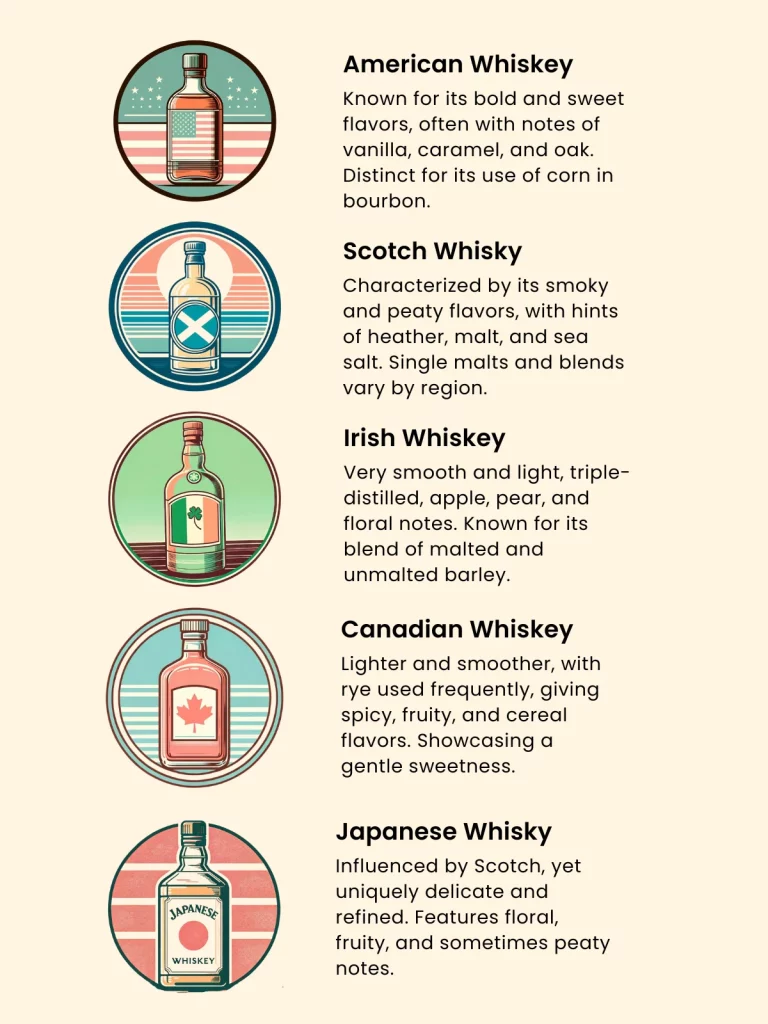
Canadian Whisky vs Irish Whiskey
Canadian Whisky stands out with its smoothness and versatility, often presenting a lighter body and a sweeter palette. In contrast, Irish Whiskey is known for its triple-distillation process, yielding an exceptionally smooth spirit with prominent fruity notes. This highlights the distinct whisky-making traditions of Canada and Ireland, each offering unique flavors and experiences.
Canadian Whisky vs American Whiskey
Comparing Canadian Whisky to American Whiskey illuminates the broad diversity within the American category. Bourbon, for example, is noted for its inherent sweetness, while American rye brings a spicier flavor to the table. Canadian whisky, with its balanced and adaptable flavor profile, offers a middle ground, providing a smooth and versatile option for a variety of tastes.
Canadian Whisky vs Japanese Whisky
Canadian Whisky and Japanese Whisky diverge in their approach to whisky-making and the resulting flavor profiles. Japanese whisky is celebrated for its precision and subtlety, often bearing resemblance to Scotch. Meanwhile, Canadian whisky is characterized by its pronounced sweetness and fuller flavors, offering a distinct contrast to the delicate and nuanced expressions of Japanese whisky.
Canadian Whisky vs Scotch Whisky
The comparison between Canadian Whisky and Scotch Whisky unveils considerable differences in taste and heritage. Scotch is famed for its regional diversity, from the peaty, complex drams of Islay to the floral, lighter whiskies of the Highlands. Canadian whisky, with its hallmark approachability and smooth finish, provides a unique experience, underscoring its own charm and versatility in the whisky realm.

